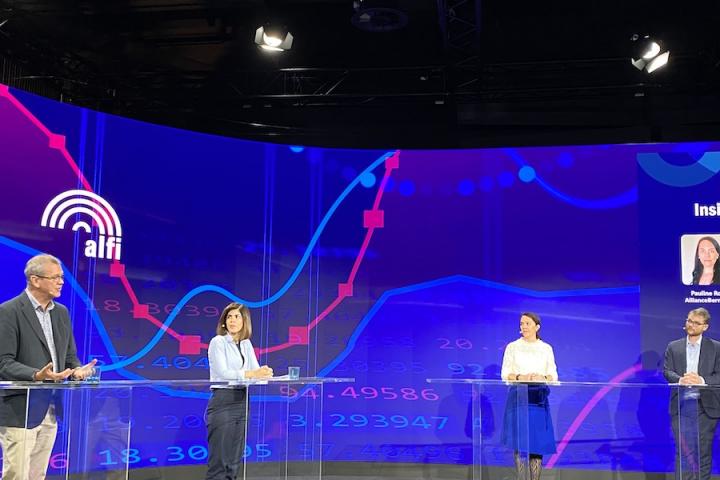
Luxembourg’s private debt market has been flourishing. But products that can pose systemic risks, difficulties with valuation, and potential misunderstandings of the risks involved in the market are issues lurking in the shadows.
The Great Financial Crisis and the Basel and Dodd-Frank rules that tightened regulatory capital rules for banks led to less lending and allowed the “perfect storm for private credit to emerge,” said Micaela Oliveira, head of Luxembourg at the private investment firm Veld Luxembourg, speaking at this week’s Association of the Luxembourg Fund Industry’s private assets conference in Kirchberg. Private credit managers stepped in with direct lending strategies, followed by the development of different products.
Despite years of growth, private debt is still seeing “very strong momentum,” said KPMG partner Julien Bieber, presenting the results of the ninth edition of the ALFI-KPMG private debt survey. Based on the survey, which polled 13 active depositary banks in Luxembourg representing over 1,500 funds, average growth in assets under management between December 2023 and December 2024 came to 25 percent. Data from a 2024 Preqin report stated that 74 percent of European private debt funds raised in 2022 were domiciled in Luxembourg.
Returns driving capital deployment
Annual expected returns is “one of the drivers of private debt,” said Bieber. Some 83 percent of funds expect returns of 1 to 10 percent; only 16 percent expect returns of 11 to 15 percent. “That’s why a lot of investors are deploying capital for private debt. You can still have a strong return with limited risk.”
Target companies are also very keen to obtain credit, added Marceau Visano, counsel at DLA Piper. Not only does going through a private debt fund allow them to avoid dilution of funds and management by “standard” VC or private equity firms. In many cases it can also be easier to access credit.
‘Relaxed underwriting’
But the flourishing private debt market brings with it challenges, like increased competition. “Because it is booming, we see much more investor demand, but we also see a lot of new credit managers that pop up in the market,” said Oliveira.
Access to institutional investors gets tougher, and that leads to pressure on the fundraising side, as well as on sourcing and closing deals. “There are so many other managers that are trying to get that one deal that they think is really good for their portfolio.” However, this must not come at the expense of “relaxed underwriting,” she cautioned. “That’s our main concern.”
A second concern is more specific to Luxembourg. “It’s making sure our structures do not become obsolete with the evolution of regulation, that actually we implement the structures in the way that we are told to do so,” said Oliveira.
Systemic risks still around
And what really keeps her awake at night? “The fear of another GFC. There are some products that can pose some systemic risks,” she said, pointing to warnings from the European Banking Authority and the US Federal Reserve concerning synthetic risk transfers, which are used by banks to transfer loan risk while keeping the loans on their books. “I think personally the regulation is strong enough to scrutinise that in the best way, but still – I’m human, so I’m afraid of another crisis. I think that we should all be cautious.”
Forbes Fenton, portfolio management conducting officer at M&G Luxembourg, echoed the need for caution, particularly when new capital enters the market. The challenge is that new players misunderstand the risks that they’re taking: excessive leverage, a lack of preparedness for liquidity crunches, or an overreliance on the ability to disinvest.
And the “unvirtuous circle” of banks lending to themselves to get things off their balance sheet? “That unnerves me,” he said. “This is a particular challenge that the industry needs to keep a careful watch on.”
Valuation gets tougher
Valuation in the private debt market is another challenge, said Fenton, who noted increased questioning from both auditors and regulators on the topic. Trying to get a clear view can be difficult. Previously, many private debt products were closed-ended vehicles. “Now, if you’re looking at more open-ended [vehicles], with money coming in and out, it’s a much more sensitive area to try and consider – and that’s one that worries me a little as well.”
An increased focus on valuation could, however, be good for the market, said Pauline Roux, vice president, legal counsel at AllianceBernstein (Luxembourg), particularly if the market enters into the retail space.
The CSSF, Luxembourg’s financial regulator, in its 2024 annual report said it had noted valuation-related shortcomings during inspections at six investment fund managers, a sign of the increasing importance dedicated to the valuation function.
The market is seeing growing cost pressures as the asset class develops. “Management fees below 1 percent make up 66 percent of the market,” said Bieber, referring to the survey findings, and “everything above management fees of 1.5 percent is decreasing.” In the face of more reporting requirements and increased cost pressures, it will be key to ensure transparency and boost efficiency with AI and tech, panelists said.